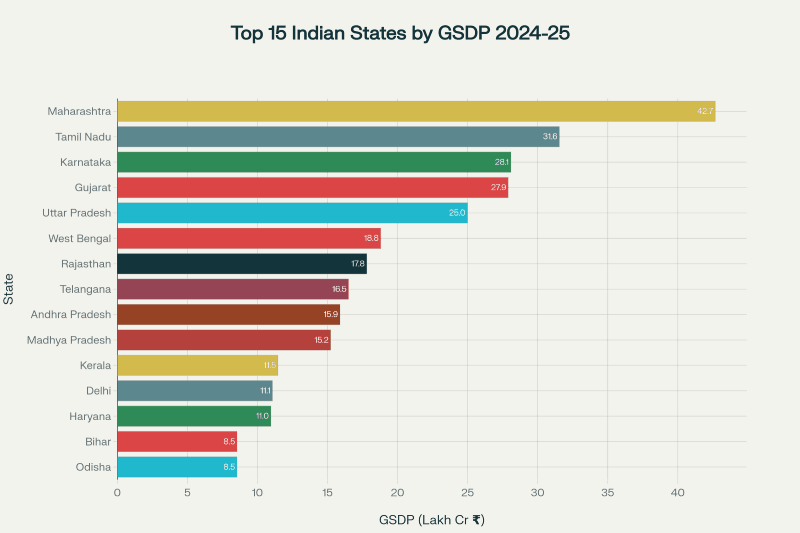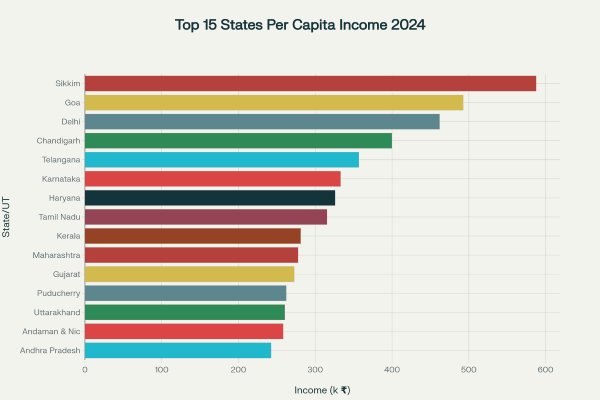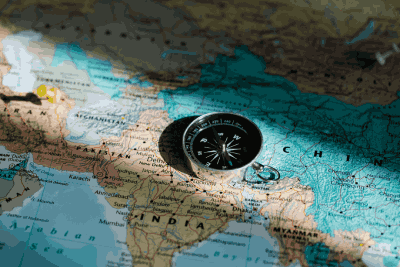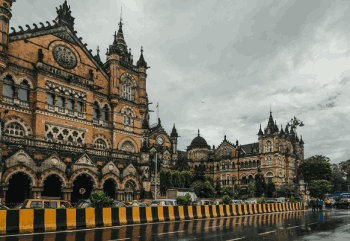India’s economy, valued at $4.1 trillion in 2024-25, is powered by the collective contribution of 28 states and 8 Union Territories. Each state brings unique strengths to the national landscape, from manufacturing hubs in the west to technology-driven economies in the south. This analysis presents a detailed overview of the economic performance of Indian states, highlighting growth trajectories, sectoral compositions, and regional disparities based on the latest data.

Top 15 Indian States by GSDP (₹ Lakh Crore) – 2024-25
Summary
India’s state economies show wide variation in terms of size, income levels, and growth. Maharashtra remains the largest contributor, accounting for 13.3% of India’s GDP, while Sikkim leads in per capita income with ₹5.88 lakh annually. The southern and western regions continue to outperform, while eastern and northern states face challenges in per capita growth and unemployment.
India’s Overall Economic Landscape (2024-25)
- National GDP: ₹321 lakh crore (FY 2024-25 projection)
- Per Capita Income: ₹1.72 lakh (national average)
- Growth Rate: 8.2% in FY 2024, higher than projected
- Sectoral Share: Services 54.7%, Industry 27.6%, Agriculture 17.7%
India remains the fifth-largest economy globally and is projected to climb to third place by 2030-31, with GDP expected to exceed $7 trillion.
Regional Analysis of State Economies
Western India – Industrial Powerhouses
Maharashtra remains the economic leader with a GSDP of ₹42.67 lakh crore, contributing 13.3% of national GDP. With Mumbai as India’s financial hub and a balanced economy across services, manufacturing, and agriculture, Maharashtra recorded a growth rate of 10.9% in FY 2024-25.
Gujarat, with a GSDP of ₹27.9 lakh crore, stands as India’s manufacturing hub. It contributes nearly 30% of the nation’s chemical output and has one of the lowest unemployment rates at 2.3%. By 2025-26, Gujarat is projected to transform into a $1 trillion manufacturing powerhouse.
Goa, although smaller in size, has the second-highest per capita income at ₹4.93 lakh, driven by tourism and mining. Its service sector accounts for 65% of the economy.
Southern India – Technology and Innovation Leaders
Karnataka (₹28.09 lakh crore GSDP) continues to thrive as India’s “Silicon Valley.” Bengaluru remains the IT capital, with $44.46 billion in FDI inflows between 2019 and 2023. Karnataka projects double-digit growth of 17.7% and plans to generate over two million jobs by 2025.
Tamil Nadu (₹31.55 lakh crore GSDP) is recognized as the “Detroit of Asia” due to its strong automobile and manufacturing base. It recorded the highest growth among major states in 2024-25 at 9.69%. Exports remain a strength, and services continue to expand.
Telangana is rapidly emerging as a major IT hub, with Hyderabad hosting a concentration of IT and pharmaceutical industries. With a GSDP of ₹16.5 lakh crore, its per capita income of ₹3.57 lakh is nearly double the national average.
Kerala, with a GSDP of ₹11.46 lakh crore, boasts the highest human development index in India. Services dominate its economy at 60% of GSDP, and the state continues to excel in health and education outcomes.
Andhra Pradesh is a leader in agriculture, producing rice and aquaculture at scale. With a GSDP of ₹15.89 lakh crore, it posted a growth rate of 8.21%, the second highest nationally.

Top 15 Indian States/UTs by Per Capita Income (₹ Thousands) – 2024
Northern and Central India – Mixed Performances
Delhi, the national capital, has a GSDP of ₹11.07 lakh crore and a per capita income of ₹4.62 lakh, ranking third nationally. Its service sector contributes 80% of the economy.
Haryana reported a GSDP of ₹10.96 lakh crore and strong per capita income (₹3.26 lakh). However, it faces one of the highest unemployment rates in India at 22.9%.
Punjab, historically an agricultural leader, is showing signs of stagnation with a GSDP of ₹7.45 lakh crore and unemployment at 7%.
Uttar Pradesh, India’s most populous state, has a GSDP of ₹24.99 lakh crore, accounting for 8.4% of GDP. However, its per capita income is among the lowest at ₹94,000 due to its vast population. Major infrastructure projects and the “One District One Product” initiative are fueling future growth.
Madhya Pradesh has steadily improved with a GSDP of ₹15.22 lakh crore, per capita income of ₹1.43 lakh, and one of the lowest unemployment rates at 0.9%.
Rajasthan posted strong growth (12.6%) with a GSDP of ₹17.8 lakh crore but faces very high unemployment (23.8%).
Chhattisgarh, with a GSDP of ₹4.6 lakh crore, relies heavily on mining and steel production, supported by a stable rural economy.
Eastern and Northeastern India – Challenges and Transformations
West Bengal contributes ₹18.8 lakh crore (5.6% of GDP) but has declined from its historic share of 10.5% in the 1960s. Services dominate its economy, though industrial stagnation persists.
Bihar continues to face poverty challenges. With a GSDP of ₹8.54 lakh crore and per capita income of only ₹60,000 (the lowest in India), it posted strong growth at 14.5% but remains dependent on agriculture.
Jharkhand, rich in minerals, has a GSDP of ₹4.5 lakh crore but lags in human development, with high unemployment (18%).
Odisha, however, stands out with strong growth (12.4%), a GSDP of ₹8.54 lakh crore, and the lowest unemployment rate in India (0.9%). Industrialization, especially in steel and mining, has fueled its success.
In the northeast, Sikkim has India’s highest per capita income at ₹5.88 lakh, driven by tourism, organic farming, and hydropower. Assam is recovering steadily, supported by tea, oil, and agriculture, and recorded a growth rate of 19.1%.
- Tripura: With strong progress in per capita income and connectivity, Tripura is emerging as a regional hub for food processing and rubber industries.
- Meghalaya: Known for coal mining and tourism, Meghalaya is leveraging its natural beauty and minerals, but seeks to diversify beyond extractive sectors.
- Manipur: Agriculture and handlooms sustain Manipur’s economy, while strategic investments in logistics and cross-border trade are spurring new growth opportunities.
- Sikkim: Sikkim leads the nation in per capita income thanks to hydropower, organic farming, and eco-tourism, setting a benchmark in environmental sustainability.
- Arunachal Pradesh: Rich in forest and hydropower resources, Arunachal Pradesh is investing in infrastructure to unlock its development potential despite challenging terrain.
- Nagaland: Nagaland is building on agriculture, horticulture, and emerging tourism, with unique cultural products adding value to its market profile.
- Mizoram: Mizoram’s economy is driven by agriculture (notably bamboo and horticulture) and has high literacy, positioning it for future growth in agro-based and service sectors.
These states collectively showcase economic diversity and untapped potential in India’s northeast.
Sectoral Highlights Across States
- Manufacturing: Tamil Nadu leads in employment, Gujarat dominates in chemicals and petrochemicals, while Maharashtra maintains a balanced industrial base.
- Agriculture: Uttar Pradesh is India’s largest producer, while Punjab has the highest productivity. Andhra Pradesh and Madhya Pradesh show strong growth in agriculture.
- Services: Karnataka and Telangana dominate IT, Maharashtra leads financial services, while Delhi specializes in government and trade-related services.
Employment Patterns
- States with highest unemployment: Haryana (22.9%), Uttar Pradesh (24%), Rajasthan (23.8%), Bihar (19%).
- States with lowest unemployment: Odisha (0.9%), Madhya Pradesh (0.9%), Gujarat (2.3%), Karnataka (2.5%).
- Over 54% of India’s workforce remains engaged in agriculture, though services and industry continue to expand in urban hubs.
Key Insights and Future Outlook
- Western and southern states continue to drive India’s growth, while eastern and northern states lag behind.
- Coastal states with maritime access generally perform better than landlocked regions.
- Manufacturing share must increase from 17% to 25% of GDP for sustainable growth.
- Infrastructure investment in eastern and northeastern states is critical for balanced development.
- Customized, state-specific policies will be crucial as India targets becoming a $5 trillion economy by 2027-28.
Conclusion
The Indian economy in 2024-25 is a mosaic of state-level performances. Maharashtra, Tamil Nadu, Karnataka, and Gujarat continue to lead as economic powerhouses, while Sikkim stands out for its high per capita income. In contrast, Bihar, Jharkhand, and parts of eastern India highlight the persistent challenges of poverty, unemployment, and underdevelopment.
India’s path to becoming a global economic giant will depend on reducing regional disparities, boosting manufacturing, and leveraging technology-driven growth. With targeted policies and infrastructure expansion, the country can ensure that lagging states also rise alongside the high performers, creating a more balanced and inclusive national economy.







